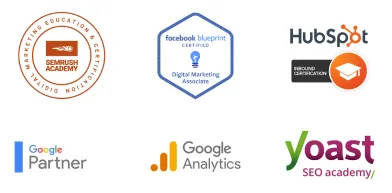TO LEARN IS TO GROW
Learning Center
We do our research and publish our results. Should probably call this the Growing Center.


How Is Content Marketing Part Of My Business Branding Efforts?
Consistency in messaging and communications is one of the most important considerations in determining the success of your company’s brand-building efforts. Content marketing serves this purpose through thoughtfully-crafted, high-quality, market-relevant content that resonates well with your audience.
These days, branding your business might start with a logo and some advertising, but it certainly goes well beyond those.
Your storefront (whether a brick-and-mortar setup or an online one), your corporate branding, and your online presence are all part of your overall branding package, but all these elements are tied together by your brand story.
Your brand story not only helps differentiate you from other players within your space, but more importantly, it serves the purpose of making you more relatable, more accessible, and -yes- even more human.
Content marketing helps win the hearts and minds of your leads and customers by telling the story of your brand— and this includes digital media as well as more traditional marketing channels.

Content is The Most Important Thing on Your Website (And Here’s Why)
The content you publish on your website is what really becomes the skeleton of your website giving shape and structure to what you are all about.
What do you do? What do you know? Why should we trust you?
It is really the critical factor in showing what sets you apart from the rest. With that in mind, we will walk you through a few of the reasons why fresh and frequent content is the most important part of your website.
Content Marketing Tells Your Brand Story
You can think of content marketing as the intersection between SEO, social media, and P.R.
This is because today’s customers turn to search and social media when they’re researching about buying something, solving a problem, or looking for answers.
If 93% of online experiences begin with a search engine, then you’ll want to be able to provide those answers, solutions, products, and services to folks looking for these.
Through effective content marketing, you can come up with a whole bunch of high-quality content that not only serves this purpose, but also aids in reinforcing your story as a brand.
Content Marketing Sells Your Brand
Along with connecting you to your customer base and keeping you there, your content acts on your website as your 24/7 salesman.
It conveys your company’s business message. In delivering your business message, you should keep in mind that whatever pitch you make is going to automatically frame your customer’s perception.
Content is so powerful you can either persuade or dissuade people from business with your company through writing and media.
One thing you should always consider as well is the power that fresh content gives you in keeping pace with changing trends.
There is always a wave to ride, and powerful content is the way you can catch it.
Content Keeps Your Brand Fresh and Relevant
New pages, articles, or updates are like the heart of your website. Just like your body runs on oxygen, your website runs on fresh content and that heart of “new pages, articles, or updates” needs to be beating constantly.
As we mentioned above, search engines generate results based on relevance but understand relevance through web crawling. Each service uses different bots that are sometimes called “spiders” to crawl the web and gather information.
Since the internet is always growing at such a rapid pace, these crawlers are always at work indexing billions of new pages and sorting them all in comparison to one another.
While they run on different algorithms on different search engines, they all know that the world is continually changing and that if the page is more recent, it is probably more relevant. If your page becomes stagnant, it falls lower down on the totem pole of search results.
Remember, that heart needs to keep pumping the life source of content into your article to keep you up there with your competitors. We don’t want to underscore the importance of design and the user experience, but fresh content is the core of sending internet traffic towards you and keeping your website alive.
Why Content is King in SEO
Content Marketing and SEO go hand in hand. Some of the best practices in search engine optimization today intersect with those of content marketing.
Remember that SEO is a marketing discipline focused on growing visibility in organic, non-paid, search engine results.
SEO encompasses both the technical and creative elements required to improve rankings, drive traffic, and increase awareness in search engines.
Every minute of every day, people use search engines to ask a question or research a problem they are having.
When you add content to your website (through a blog, a resource page, or even your “About Us” section), search engines index your keywords, key phrases, and topics, and then match these when someone enters a query or asks a question.
Search engines like Google and Bing are basically dating sites between customers and businesses. The best part is that it works both ways.
While a consumer fills in on Google a question or description of what they are looking for, businesses can do the exact same thing by creating and publishing content on their website.
For example, let’s say you are a roofing company that is trying to cover the United States and have just set up shop in Rocklin, California.
So your target market now includes those from Northern California; specifically, those in and around Rocklin, which may include neighborhoods in Roseville, Loomis, Granite Bay, and Lincoln.
Now you just have to think about what people in these neighborhoods would be looking up that would have anything to do with roofing repair, maintenance, or installation.
By publishing articles on your website, like “what can happen to your roof during a hailstorm” or “how can I install solar panels on my roof?”, you’re better able to connect your brand to your target market.
Search engines (such as Google) use many different SEO factors (as many as 200+, in Google’s case) to figure out what type of content you are searching for.
Remember that these search engines run on the principle of “relevance”.
All the pages their web crawlers have indexed come up depending on how relevant they are to the topic or subject searched.
The search engines then list in a certain order, again based on SEO factors, and present all the finding in front of the person that was doing the search.
Therefore, your job in creating content is to know what sort of questions your target audience is asking and answer those questions.
This is where your content is KEY because you want your website, article or whatever to be in the top searches found. A website’s content, even more so than its products, is what attracts visitors.
The key part of SEO is the content because search engines cannot see pictures, so you need to provide detailed information of topics or subject matters present within your website in text form.
Oftentimes individuals worry more about the general look of their website. They think that the design of their website is what is going to attract visitors.
More appropriately, think of content as that which brings leads and potential customers to your site. Together with thoughtful web design, just-as-thoughtful content keeps them there, especially if they’ve found something genuinely useful that can solve their problems or answer their questions
Tips For Better SEO Content
Today, SEO isn’t just for those out to make a quick buck. Respectable businesses are learning how to optimize their websites so they can be found by people who are searching for the products and services they want to sell.
This means, of course, that they don’t just want visitors to drop by once. They hope to keep them coming back. This is why content is so important.
1. Think about giving your audience the best possible user experience.
Be genuinely helpful. Make your information easy to access and a joy to read. Content should be well written and express your authority in the niche.
2. Do keyword research.
When creating content, choose a topic and stick to it. Keyword research helps you focus so you keep your efforts down to a very specific set of topics
3. Throw out outdated SEO practices.
Once upon a time, if you wanted to use SEO to increase your rankings, you simply crammed your website as full of keywords as possible.
Some less scrupulous web designers used to cram their sites full of popular, but irrelevant, keywords. Of course, that only worked for websites that just wanted to display ads and were not concerned with getting visitors to come back.
4. Get inspiration from other sources.
You have no shortage of content ideas to be inspired by. You can even look into what your competitors are doing (so you can come up with something better), industry developments, or what others in your space are also coming up with.
5. Avoid fluff.
No need to beat around the bush; provide answers and solutions right away, and then have supporting facts and information instead.
6. Quality over quantity.
These days, it’s more important to come up with amazing, market-relevant, comprehensive pieces of content once a week or even once a month, than pumping out mediocre content daily.
Well-optimized content these days are usually long-form articles of about 2,000 words.
7. Supplement your articles with other media.
Featuring lots of great visuals, videos, links to your other pages as well as trusted sources within your chosen topic will greatly benefit your marketing efforts.
8. You’re not just limited to blog articles.
These will still be the backbone of your content marketing strategy, but also consider mixing in an occasional downloadable resource like a checklist, a guide, an industry report, as well as podcasts, infographics, and branded video.
9. Master your on-page optimization.
After you create your content, pay attention to all the little details on your site that make you more search-engine-friendly: your tags and descriptions, your headline, your internal and external links, among others.
10. Organize your content into hubs and clusters.
By doing so, you’re not only helping your readers find other pieces they might find useful, but you’re also helping search engines make better sense of what your site (and brand) is all about.
11. Promote your content.
Great content might be able to promote itself, but pushing it along through some promotion of your own will certainly help.
Incorporate these into your email marketing and social media campaigns. Invest in a little PPC advertising. And you can even look for opportunities to be a guest on other blogs, podcasts, or video channels.
Remember: write for your target audience, not for search engines.
Obtaining high-quality SEO content is accomplished when you write content that engages the reader, keeps them interested, and coming back for more.
This will help to attract more visitors to your site who will keep coming back for fresh content and updates on your products and industry developments.
The best part about content marketing is that you can do it for free. As long as you invest some time into creating content that will provide value to your target audience, you won’t have to spend a dime.

A Final Word on Content Marketing and Brand Building
The more high-quality and market-relevant content you create, the more you’re also helping with your brand-building efforts.
Coherence, clarity, and consistency in your content marketing efforts are key in helping grow your brand, and serves to supplement your other branding activities and initiatives.
Ultimately, good content marketing is all about good storytelling.
Keep creating amazing (but helpful) content to tell your story as a brand, and by doing so, you’ll also keep winning over new fans, followers, clients, and repeat customers.
Growing Businesses Since 2008
We have helped hundreds of businesses just like yours. Working for or along-side of business owner, managers, staff, or even board of directors, LOJO is ready to be an asset to your business.
Our team has been curated through the years for individual skills, personalities, and capabilities. Our clients put their trust in us to help them grow. We are here to do just that.



Growing Businesses Since 2008
We have helped hundreds of businesses just like yours. Working for or along-side of business owner, managers, staff, or even board of directors, LOJO is ready to be an asset to your business.
Our team has been curated through the years for individual skills, personalities, and capabilities. Our clients put their trust in us to help them grow. We are here to do just that.




Matthew Rogers, President
iProspect Check
After spending several months reviewing multiple proposals from several different companies we engaged LOJO to develop a new website that represents our company effectively. We worked initially with Stephen Platte who helped create the scope of the project. Stephen was knowledgeable and always followed up with me on time and as promised.
He "closed the deal" for LOJO with his professionalism, service orientation and easy going approach. Once we signed the contract we were introduced to Jay Kelly who would be the creative lead for LOJO. This was the most challenging part of the project for my company, as there was no shortage of ideas from our side. Jay managed the project flawlessly, and once we had all agreed to the design, Jay introduced us to Eric.
Eric Lay is one of the founders of LOJO. Eric took the design we had developed and brought it to life. We delivered content as quickly as he requested it. Eric kept the project on task and we responded by exceeding every deadline for content. In turn, once provided, literally not a day went by that Eric didn't add the content and take the next step. In just a few weeks we launched our new website. Eric is a pleasure to work with.
His positive attitude and consultative approach really enhanced the experience and made a big difference for us in the outcome of our project. We would welcome you to visit our website to take a look at the quality work of LOJO. We are very pleased with LOJO and look forward to working with them in the future as we pursue an aggressive SEO strategy."
After spending several months reviewing multiple proposals from several different companies we engaged LOJO to develop a new website that represents our company effectively. We worked initially with Stephen Platte who helped create the scope of the project. Stephen was knowledgeable and always followed up with me on time and as promised.
He "closed the deal" for LOJO with his professionalism, service orientation and easy going approach. Once we signed the contract we were introduced to Jay Kelly who would be the creative lead for LOJO. This was the most challenging part of the project for my company, as there was no shortage of ideas from our side. Jay managed the project flawlessly, and once we had all agreed to the design, Jay introduced us to Eric.
Eric Lay is one of the founders of LOJO. Eric took the design we had developed and brought it to life. We delivered content as quickly as he requested it. Eric kept the project on task and we responded by exceeding every deadline for content. In turn, once provided, literally not a day went by that Eric didn't add the content and take the next step. In just a few weeks we launched our new website. Eric is a pleasure to work with.
His positive attitude and consultative approach really enhanced the experience and made a big difference for us in the outcome of our project. We would welcome you to visit our website to take a look at the quality work of LOJO. We are very pleased with LOJO and look forward to working with them in the future as we pursue an aggressive SEO strategy."

Matthew Rogers, President
iProspect Check
The team at LOJO were wonderful to work with. They are well organized and very patient as we worked through our marketing strategy and developed a well thought out and clear action plan at a reasonable price. We will definitely be back for our future campaign needs."

Jon Crosby, Founder
Dazil

